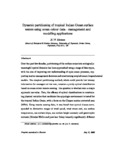Dynamic partitioning of tropical Indian Ocean surface waters using ocean colour data — management and modelling applications
| dc.contributor.author | Schwarz, Jill | |
| dc.date.accessioned | 2020-09-21T18:10:35Z | |
| dc.date.available | 2020-09-21T18:10:35Z | |
| dc.date.issued | 2020-12-15 | |
| dc.identifier.issn | 0301-4797 | |
| dc.identifier.issn | 1095-8630 | |
| dc.identifier.other | 111308 | |
| dc.identifier.uri | http://hdl.handle.net/10026.1/16413 | |
| dc.description.abstract |
Over the past few decades, partitioning of the surface ocean into ecologically-meaningful spatial domains has been approached using a range of data types, with the aim of improving our understanding of open ocean processes, supporting marine management decisions and constraining coupled ocean-biogeochemical models. The simplest partitioning method, which could provide low-latency information for managers at low cost, remains a purely optical classification based on ocean colour remote sensing. The question is whether such a simple approach has value. Here, the efficacy of optical classifications in constraining physical variables that modulate the epipelagic environment is tested for the tropical Indian Ocean, with a focus on the Chagos marine protected area (MPA). Using remote sensing data, it was found that optical classes corresponded to distinctive ranges of wind speed, wind stress curl, sea surface temperature, sea surface slope, sea surface height anomaly and geostrophic currents (Kruskal-Wallis and post-hoc Tukey honestly significantly different tests, α = 0.01). Between-class differences were significant for a set of sub-domains that resolved zonal and meridional gradients across the MPA and Seychelles-Chagos Thermocline Ridge, whereas between-domain differences were only significant for the north-south gradient (PERMANOVA, α = 0.01). A preliminary test of between-class differences in surface CO2 concentrations from the Orbiting Carbon Observatory-2 demonstrated a small decrease in mean pCO2 with increasing chlorophyll (chl), from 418 to 398 ppm. Simple optical class maps therefore provide an overview of growth conditions, the spatial distribution of resources - from which habitat fragmentation metrics can be calculated, and carbon sequestration potential. Within the 17 year study period, biotic variables were found to have decreased at up to 0.025%a-1 for all optical classes, which is slower than reported elsewhere (Mann-Kendall-Sen regression, α = 0.01). Within the MPA, positive Indian Ocean Dipole conditions and negative Southern Oscillation Indices were weakly associated with decreasing chl, fluorescence line height (FLH), eddy kinetic energy, easterly wind stress and wind stress curl, and with increasing FLH/chl, sea surface temperature, SSH gradients and northerly wind stress, consistent with reduced surface mixing and increased stratification. The optical partitioning scheme described here can be applied in Google Earth Engine to support management decisions at daily or monthly scales, and potential applications are discussed. | |
| dc.format.extent | 0-0 | |
| dc.format.medium | Print-Electronic | |
| dc.language | en | |
| dc.language.iso | en | |
| dc.publisher | Elsevier BV | |
| dc.subject | Remote sensing | |
| dc.subject | Biogeography | |
| dc.subject | Habitat fragmentation | |
| dc.subject | Multi-sensor | |
| dc.subject | Orbiting Carbon Observatory-2 (OCO-2) | |
| dc.subject | Marine protected area | |
| dc.subject | Epipelagic | |
| dc.title | Dynamic partitioning of tropical Indian Ocean surface waters using ocean colour data — management and modelling applications | |
| dc.type | journal-article | |
| dc.type | Journal Article | |
| plymouth.author-url | https://www.webofscience.com/api/gateway?GWVersion=2&SrcApp=PARTNER_APP&SrcAuth=LinksAMR&KeyUT=WOS:000593970900003&DestLinkType=FullRecord&DestApp=ALL_WOS&UsrCustomerID=11bb513d99f797142bcfeffcc58ea008 | |
| plymouth.volume | 276 | |
| plymouth.publication-status | Published | |
| plymouth.journal | Journal of Environmental Management | |
| dc.identifier.doi | 10.1016/j.jenvman.2020.111308 | |
| plymouth.organisational-group | /Plymouth | |
| plymouth.organisational-group | /Plymouth/Faculty of Science and Engineering | |
| plymouth.organisational-group | /Plymouth/REF 2021 Researchers by UoA | |
| plymouth.organisational-group | /Plymouth/REF 2021 Researchers by UoA/UoA07 Earth Systems and Environmental Sciences | |
| plymouth.organisational-group | /Plymouth/Research Groups | |
| plymouth.organisational-group | /Plymouth/Research Groups/Marine Institute | |
| plymouth.organisational-group | /Plymouth/Users by role | |
| plymouth.organisational-group | /Plymouth/Users by role/Academics | |
| dc.publisher.place | England | |
| dcterms.dateAccepted | 2020-08-23 | |
| dc.rights.embargodate | 2021-9-3 | |
| dc.identifier.eissn | 1095-8630 | |
| dc.rights.embargoperiod | Not known | |
| rioxxterms.versionofrecord | 10.1016/j.jenvman.2020.111308 | |
| rioxxterms.licenseref.uri | http://www.rioxx.net/licenses/all-rights-reserved | |
| rioxxterms.licenseref.startdate | 2020-12-15 | |
| rioxxterms.type | Journal Article/Review |


